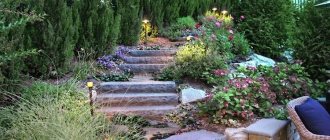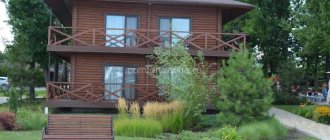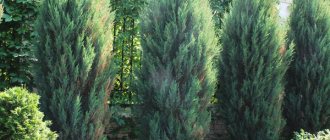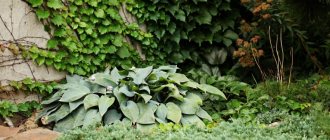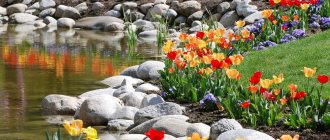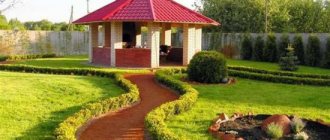Any owner of a dacha plot, albeit a small one, dreams of creating the flowerbed of his dreams, decorating it, among other things, with ornamental plants. Landscape design is a whole science that includes not only an understanding of the combination of different shades, but also the ability to combine plants that would be able to get along in one flowerbed. When forming a garden, some take as a basis already planted juniper bushes, which belong to the category of unpretentious plants that can maintain a beautiful appearance for a long time. However, not every plant will like such a neighborhood, so what should you plant next to the juniper?
Features of landscape planning with junipers and thujas
When creating compositions, it is necessary to take into account the type of landscape, since coniferous plants are not suitable for everyone. It would not be appropriate to use conifers when planning fruit or tropical gardens. At the same time, they will harmoniously fit into rocky landscape compositions, as well as ensembles with lichens, mosses and heather.
Good and bad neighbors
Juniper belongs to the category of unpretentious crops that have the ability to maintain an attractive appearance for a long time. But such a neighborhood may not be suitable for every plant.
Before planting any crops nearby, you need to carefully study the varietal characteristics of future companions. Also when landing you should:
- Consider the type of conifer. For example, horizontal juniper does not grow too tall, so it will not interfere with other plants nearby. Whereas the columnar one can shade its neighbors. Accordingly, it is not recommended to plant light-loving crops next to it, as they will develop poorly.
- Pay attention to the composition of the soil in your garden plot. The beneficial substances it contains should be suitable not only for the juniper, but also for the companion.
Attention! Coniferous plants can acidify the soil. This feature should be taken into account when selecting neighbors, since some crops cannot fully develop in acidic soils.
Good neighbors for juniper can be:
- deciduous shrubs;
- annual and perennial plants;
- cereal crops.
It is acceptable to place flowers such as clematis, roses and peonies nearby, but such proximity has some peculiarities. Despite the fact that these crops are compatible, they should not grow too close. It is recommended to place them at a distance of 1-2 m from the conifer.
Juniper can also be a bad neighbor for fruit trees, as it is an intermediate host of rust fungi. Therefore, it is not recommended to plant common, virginian, rocky and horizontal species next to an apple tree, and Cossack and middle ones near a pear tree.
This conifer should not be placed next to birch and bird cherry. These trees will absorb all trace elements from the soil as much as possible. Such a neighborhood will have negative consequences for juniper.
Design styles with juniper
It is possible to use junipers when decorating a site in Japanese, English or French styles with classic, strict and elegant elements. Below are photos of various composition options.
Landscape design in the Japanese style requires the mandatory use of ponds, rocky islands and cobblestones protruding above the ground
The basis of the French style is the use of evergreen coniferous plants of geometric shapes, symmetrically located on the territory
For the English style, elements symbolizing antiquity are mandatory, for example, antique household items
Cultivation and planting methods
Juniperus variegata is one of the most unpretentious and frost-resistant plant species. It can be planted in stony, rocky, acidic, and also oily soil. This juniper is perfect for shady places.
Astilbe in landscape design
To plant a shoot, you need to dig a hole several times larger than its roots, then add drainage in the form of old loose bricks or small stones to the bottom. If the soil type is acidic, then it is worth adding lime or dolomite flour. You should definitely loosen the soil, then place the shrubs. Before this, it is advisable to treat parts of the plant with a solution of potassium permanganate. It would not be bad if the seedling had a closed root system. It must be placed in the planting hole along with a lump of earth from the pot. After this, the roots are covered with sand. Well, in the end, fill the remaining space with sawdust or tree bark, because this can protect against the appearance of weeds.
For horizontal juniper, loamy or sandy loam soil types are best suited. Otherwise, all planting rules for junipers are the same.
Important! The main thing is to ensure good soil drainage, since shrubs do not like stagnant water. Also, do not plant them in clay soil.
This species should be planted in the spring in a well-lit place.
Varieties of Chinese juniper are absolutely not shade-tolerant and will certainly die if planted in the wrong place. The ideal time for planting would be April or May, as well as the beginning of September.
In general, all types of shrubs require the same care and planting algorithm, but with the slight difference that some varieties are suitable only for specific soil types. And, despite the fact that most juniper varieties can grow in the shade, you still need to ensure constant sunlight.
For your information! In order for the seedlings to take root better, it is recommended to replace the soil around the roots with a sand-peat mixture.
Water the plant with special care. If it grows in a place where groundwater comes close to the surface of the earth, watering must be done so as not to flood the plant with water. In one season, it is worth providing the juniper with about 5 waterings. In the hot season, their number needs to be increased. In addition, the branches should be regularly sprayed with water to maintain the beautiful appearance of the needles.
Features of landscape design with coniferous plants
The use of coniferous crops to create compositions is one of the classic trends in landscape design. With their help, you can beautifully decorate your home area, which will delight you all year round.
Globular shrubs and tall spruce trees Source www.arcadiagarden.ru
Exquisite appearance, variety of shapes, sizes and shades make it possible to create spectacular compositions. Main landing placement options:
- along the perimeter of the territory as hedges;
- by territory;
- along the paths.
Living green hedges of different levels Source decore.pw
Path in the yard between conifers Source pinterest.com
In addition to high aesthetic qualities, conifers have other important advantages:
- create a reliable barrier against dust and gases flying from the road;
- weaken gusts and prevent winds from weathering the soil;
- reduce noise levels.
In places where a large number of conifers grow, the air is saturated with phytoncides. These substances negatively affect the life of pathogens and are even capable of fighting viruses. Staying among evergreens relieves fatigue, improves well-being and mood.
Elm-pear aphid (Eriosoma lanuginosum)
Aphids, hatched from eggs overwintering on various types of elms (Ulmus) , suck the juices from young leaves, causing the formation of large (6–7 cm in diameter) bag-like galls on them. Sometimes damaged leaves curl into a spiral and turn into a pale green, closed gall. In the second half of summer, aphids migrate to thin roots, less often to pear and quince , where several generations of aphids develop throughout the growing season. The development cycle is two years. They mainly harm 1–2 year old pear seedlings in the nursery. They are found in the southern regions of the European part of Russia, the Caucasus, Ukraine, Western Europe, North Africa, Asia Minor and Central Asia. Introduced to North America and Australia.
Elm
Pear
Option 1. Thuja in solo planting
“On its own,” the thuja can be an excellent solitaire accent on any garden plot and lawn. Ideally, this plant will contrast in color and shape with the surrounding plantings.
Its austere beauty and delicacy of branches will perfectly set off the minimalist style of the surface - a short-cut, smooth green lawn, a densely mulched or crushed area, a plain smooth wall or fence, large stones of a rough texture.
And thanks to the fact that thuja is very grateful for pruning, based on your ideas about landscape design and the general concept of the appearance of the site, you can form the most bizarre shapes from this tree, which will certainly become the “highlight” of the garden.
Why I love ROSES and CONIFEROUS PLANTS nearby.
Rose - Queen of the Garden. I completely agree with this for various objective reasons. And, like the Queen, the rose should not be overshadowed by other flowers. In general, it is difficult to imagine that someone can outshine a rose. But you can introduce dissonance with the help of other “companion” colors, which in fact are not companions at all.
How NOT to do it. Rose Pat Austin and marigolds. It happened to me by accident. I won't repeat it. On the left, by the way, are the needles of the thuja Smaragd. Thuja is still a baby.
Coniferous plants, in my opinion, complement the beauty of roses. They are not flowering, naturally, and this is the main advantage. And the needles of various shades (green, blue, yellowish, lime) beautifully set off our Queen of the garden.
I like the combination of roses with conifers and the fact that when the roses are pruned in the fall and have not yet begun to grow in the spring, my rose gardens do not seem empty. The picture is perfectly enlivened by coniferous plants.
From bottom to top: juniper Lime Glow (autumn color), microbiota, juniper Variegata, thuja Mr. Bowling Ball (edge visible



